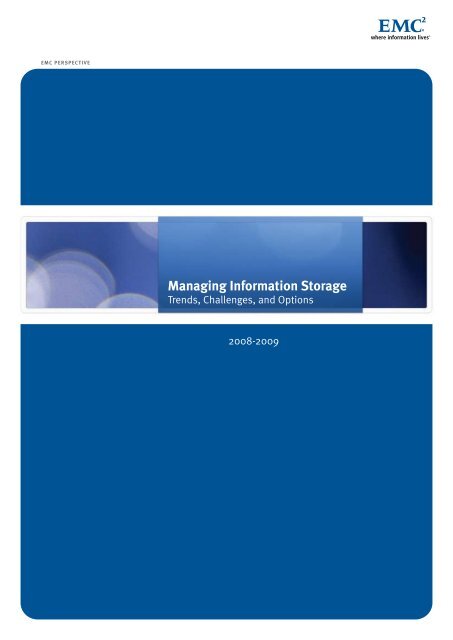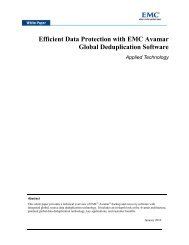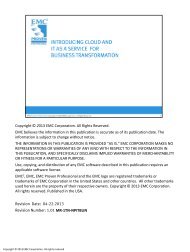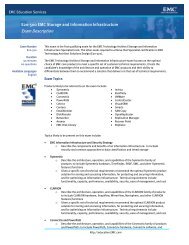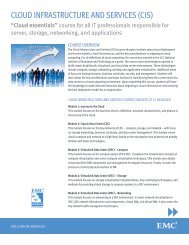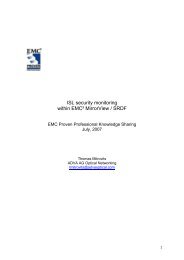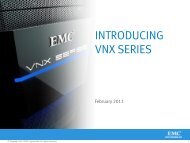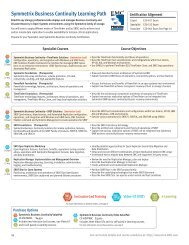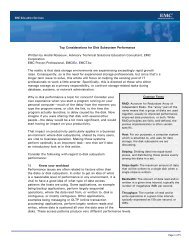Managing Information Storage - EMC Education, Training, and ...
Managing Information Storage - EMC Education, Training, and ...
Managing Information Storage - EMC Education, Training, and ...
- No tags were found...
Create successful ePaper yourself
Turn your PDF publications into a flip-book with our unique Google optimized e-Paper software.
<strong>EMC</strong>’s Response <strong>and</strong> Initiatives<strong>EMC</strong> recognizes the need for more highly skilled professionals in its customer base <strong>and</strong> across theentire IT industry. <strong>EMC</strong> conducted this study to identify deficiencies in the storage industry <strong>and</strong> toidentify how we can contribute to addressing these challenges.The following key initiatives offer options for storage managers <strong>and</strong> professionals to acquire orimprove their skills to benefit their organizations:<strong>Education</strong> Solutions• ‘Open’ <strong>Storage</strong> Technology Curriculum– Unique offering in the industry; leads with concepts <strong>and</strong> principles– Covers all segments <strong>and</strong> aspects of information storage <strong>and</strong> management technology• <strong>EMC</strong> Technology-Specific Learning Paths– Help leverage extensive capabilities of <strong>EMC</strong> technology <strong>and</strong> solutions– Comprehensive coverage for all segments of <strong>EMC</strong> technology• <strong>EMC</strong> Proven Professional Certification Program– Formal validation <strong>and</strong> recognition– Option of ‘Open’ <strong>and</strong>/or more than 10 <strong>EMC</strong> technology specialties– Exclusive Knowledge Maintenance <strong>and</strong> Sharing featureAll of the above education solutions are available globally via <strong>EMC</strong> ® <strong>Education</strong> Services to <strong>EMC</strong>’scustomers, partners, <strong>and</strong> employees.In an attempt to help address the widening knowledge gap in the industry, the following exclusiveprograms were introduced to enable non-<strong>EMC</strong> users, as well as university students, to take advantageof the ‘open’ storage technology curriculum to build a successful career in this high-growth industry:<strong>EMC</strong> Academic Alliance Program‘Open’ information storage <strong>and</strong> management curriculum for students in colleges <strong>and</strong> universities,targeted to help build a highly skilled pool of future storage managers <strong>and</strong> professionals.<strong>EMC</strong> Learning Partner Program‘Open’ storage technology curriculum, offered by leading, independent IT training companies,designed to build or improve storage technology skills leading to better design <strong>and</strong> management ofefficient storage infrastructures.4
1. IntroductionIn a recent study commissioned by <strong>EMC</strong>, the industry analyst firm IDC estimates that the total volumeof digital information created in 2011 will surge six-fold to an astonishing 1,773 exabytes—1,773billion gigabytes—compared to 2007 (281 exabytes). And while most of this information will becreated by individuals, 85 percent of it will be managed by organizations.This unprecedented explosion of data, its increasing criticality, <strong>and</strong> business dependency ondigital information are leading to larger <strong>and</strong> more complex information storage environments thatare increasingly challenging to manage. From the perspective of data availability <strong>and</strong> protection,information storage infrastructure is the most critical component of an overall IT infrastructure. Itplays a critical role in making applications work efficiently, both locally <strong>and</strong> across multiple sites.With the increasing complexity <strong>and</strong> criticality of storage, highly skilled <strong>and</strong> focused storage groupsare as mission-critical as the technology being deployed.This paper summarizes a global research study that was conducted to learn how companies aremeeting these challenging requirements. These findings will assist IT <strong>and</strong> storage managers tocompare <strong>and</strong> correlate their plans with the overall trends in the industry. Even though each companyhas unique requirements, this information will be helpful in building stronger <strong>and</strong> more efficientstorage management teams. Stronger storage management teams will, in turn, lead to more robuststorage infrastructures.The first such study was carried out by <strong>EMC</strong> in 2005-2006 <strong>and</strong> was found to be very useful by IT<strong>and</strong> storage managers globally. The updates <strong>and</strong> revisions include:• Most current information via global survey of over 1,400 managers (20 percent) <strong>and</strong> storageprofessionals (80 percent)• <strong>Information</strong> on data centers <strong>and</strong> processing centers instead of entire enterpriseFigure 1:Geographic distribution of survey participantsAsia PacificJapan17%EuropeMiddle East26%Americas57%• Focus on usable storage capacities instead of installed raw capacities• Further details related to storage groups such as job titles, tasks <strong>and</strong> responsibilities, <strong>and</strong>hiring plansGlobal trends are identified in areas related to:• Technical environments• Management challenges• Practices for building storage management groups• Options for acquiring more or better storage skillsFigure 2:Annual revenue of companies surveyedNot Known33%%Over $1B25%Up to $100M15%$100M-$500M15%$500M-$1B12%The study was carried out between December 2007 <strong>and</strong> February 2008. We used comprehensivesurveys <strong>and</strong> reached out to thous<strong>and</strong>s of storage professionals to assemble <strong>and</strong> compile thisinformation.The study included:• All major geographies <strong>and</strong> major industry segments• <strong>EMC</strong> users as well as those using storage solutions from other vendors• Large, medium, <strong>and</strong> small enterprises5
2. Challenges Faced by IT <strong>and</strong> <strong>Storage</strong> ManagersIT <strong>and</strong> storage managers identified the following activities <strong>and</strong> constraints as their key challenges.These challenges (Table 1) are common to both large enterprises as well as SME (small <strong>and</strong> mediumenterprises) sectors of the industry.Challenges identified by IT <strong>and</strong> <strong>Storage</strong> Managers<strong>Managing</strong> storage growthDesigning, deploying, <strong>and</strong> managing backup <strong>and</strong> recoveryDesigning, deploying, <strong>and</strong> managing disaster recovery solutionsMaking informed strategic/big-picture decisionsDesigning <strong>and</strong> deploying emerging storage technologies (such as storage virtualization,IP-SAN, GRID, etc.)Designing <strong>and</strong> deploying multi-site environmentsLack of skilled storage professionals<strong>Managing</strong> data availability/data retention complianceTable 1: What keeps them awake? Pain points in order of priority identified by managersEach of these activities is ongoing at various levels in each of the companies. Activities such asbackup/recovery have been in practice for decades; still the professionals believe that they arenot doing enough or not performing them well. Table 2 summarizes the input from managers <strong>and</strong>professionals. There is a strong synergy between the managers <strong>and</strong> individual contributors asthey have identified exactly the same challenges in similar priority order.IT <strong>and</strong> <strong>Storage</strong> Managers82% <strong>Managing</strong> storage growth60% Designing, deploying, <strong>and</strong> managing backup <strong>and</strong> recovery59% Designing, deploying, <strong>and</strong> managing disaster recovery solutions51% Making informed strategic/big-picture decisions45% Designing <strong>and</strong> deploying emerging storage technologies (such as storage virtualization,IP-SAN, GRID, etc.)31% Designing <strong>and</strong> deploying multi-site environments26% Lack of skilled storage professionals21% Compliance regulations<strong>Storage</strong> Professionals81% <strong>Managing</strong> storage growth63% Designing, deploying, <strong>and</strong> managing backup <strong>and</strong> recovery58% Designing, deploying, <strong>and</strong> managing disaster recovery solutions48% Making informed strategic/big-picture decisions42% Designing <strong>and</strong> deploying emerging storage technologies (such as storage virtualization,IP-SAN, GRID, etc.)31% Designing <strong>and</strong> deploying multi-site environments28% Lack of skilled storage professionals19% Compliance regulationsTable 2: Most important activities/constraints identified as challenges by managers <strong>and</strong> professionals6
Explosive growth in storage requirements <strong>and</strong> the storage professionals’ knowledge <strong>and</strong> skill gapsare the primary reasons for not executing many of these activities to the desired levels. These gapsare not necessarily due to lack of competence, but to the fact that a comprehensive storage technologyeducation has not been available. For example, colleges <strong>and</strong> universities have not, until now,included information storage <strong>and</strong> management in their courses. On the other h<strong>and</strong>, vendor trainingtypically focuses on their products covering deployment <strong>and</strong> usage rather than building skills <strong>and</strong>competency to architect, design, integrate, <strong>and</strong> manage an entire infrastructure <strong>and</strong> end-to-endinformation lifecycle management.We will learn the methodology by which most storage professionals acquire knowledge <strong>and</strong> buildskills to carry out their assignments in section 4 of this paper.Figure 3:Distribution of multi-site data processingenvironments (Number of data centers/processing facilities across representedcompanies)3. Complex <strong>Storage</strong> EnvironmentsThis study sought to determine the similarities <strong>and</strong> differences among storage infrastructures. Theresponses reveal that data centers across the Americas, Europe, <strong>and</strong> Asia have deployed very similarstorage solutions, including hardware <strong>and</strong> software. The sizes vary based upon business requirements,or in some cases, a particular vendor may have a stronger presence in a given environment,but on the whole, the deployed technology <strong>and</strong> challenges are very similar.• Nearly 75 percent of the companies have multi-site data processing environments• Nearly 80 percent of the companies are at various stages of storage consolidationMore thanthree38%Three13%One18%Two31%• Nearly 45 percent of the companies have 100 TB or more of usable storage to manage• Average installed usable capacity has doubled to 450 TB compared to the previous year of 222 TB.3.1 <strong>Storage</strong> Technology Segments<strong>Storage</strong> technology deployment <strong>and</strong> its importance to the data center aligned with general markettrends for each of the storage technology segments:Figure 4:Distribution of storage capacity acrossrepresented companies• <strong>Storage</strong> subsystems, by default, are the most important segment as they provide the backboneinfrastructure, storage capacity, reliability, availability, performance, <strong>and</strong> connectivity.• Two segments, storage areas networks (SANs) <strong>and</strong> backup/recovery (BR) were rated important bymore than 75 percent of the storage professionals.500TB-1PB9%Over 1PB15%100-500TB23%Up to 100TB53%• Remote replication was considered important by 50 percent of storage professionals• NAS, virtualization, <strong>and</strong> local replication are considered important by 25-50 percent of theprofessionals• CAS, IP-SAN, <strong>and</strong> emerging technologies are considered important by 12 percent of theprofessionalsEach of the technology segments is unique, bringing its own specific business or operational values.For example, SAN <strong>and</strong> NAS provide connectivity options with unique functionality, while BR <strong>and</strong>replication technologies provide options for information protection against planned <strong>and</strong> unplannedoutages.7
IP-SANCASLocal ReplicationVirtualizationNASRemote ReplicationBackup/RecoverySAN0% 20% 40% 60% 80% 100%% RespondentsFigure 5: <strong>Storage</strong> technology segments <strong>and</strong> their relative importanceIP-SANCASVirtualizationDASReplicationNASBackup/RecoverySAN0% 20% 40% 60% 80% 100%% RespondentsFigure 6: Most common storage technology segments implementedThese technology segments (Figures 5 <strong>and</strong> 6) are at various stages of evolution <strong>and</strong> maturity. Eachis considered sophisticated <strong>and</strong> complex, <strong>and</strong> each requires unique skills to assess, plan, design,deploy, <strong>and</strong> manage them effectively. Deploying specialized experts within the teams, dedicated totheir specialty segments, is the most effective way to manage such diverse technology.8
4. Formalized <strong>Storage</strong> Groups<strong>Storage</strong> infrastructure is mission-critical <strong>and</strong> nearly 40 percent of infrastructure budgets is allocatedto storage-related products <strong>and</strong> services. A well structured storage group of highly skilled professionalsis critical to building <strong>and</strong> maintaining high-performance, highly available storage infrastructures.Job titles <strong>and</strong> descriptions of dedicated storage professionals are evolving. The following are the mostcommon job functions being deployed by the studied organizations:• <strong>Storage</strong> Manager–Manager of the formalized storage team or used interchangeably for <strong>Storage</strong>Administrator• <strong>Storage</strong> Administrator–Responsible for day-to-day administration, provisioning, configurationmanagement, monitoring, availability management, etc.• Backup <strong>and</strong> Recovery Administrator–Responsible for day-to-day backup <strong>and</strong> recovery relatedoperations• <strong>Storage</strong> Architect–Responsible for capacity planning, technology planning/design, <strong>and</strong> processmanagement• Disaster Recovery Administrator or Business Continuity Administrator–Responsible for disasterrecovery, backup <strong>and</strong> recovery, planning, implementation, <strong>and</strong> managementStore Managers<strong>Storage</strong> AdministratorsBR Administrators<strong>Storage</strong> ArchitectsBC AdministratorsOthers0% 10% 20% 30% 40%Figure 7: Distribution of storage-related functions4.1 Responsibilities<strong>Storage</strong> groups are responsible for the overall planning, design, implementation, monitoring,managing, testing, <strong>and</strong> operating of all components of the infrastructure. Interactions with IT <strong>and</strong>storage managers <strong>and</strong> professionals resulted in the list of activities/tasks for which they are responsible(Table 3).The list includes various job functions, including storage administration, architects, DR administration,BR administration, etc. Percent time captured for each of the activities highlights the effortinvolved <strong>and</strong> possible importance of the tasks. This list could be used as a tool to define responsibilitiesof the storage group <strong>and</strong> individuals.9
<strong>Storage</strong> Group - Tasks & Responsibilities<strong>Managing</strong> the implementation of storage infrastructure 11.9%Integration of the storage infrastructure, databases, <strong>and</strong> applications 10.9%Backup <strong>and</strong> recovery of information/data 10.5%Design <strong>and</strong>/or participate in the design of storage infrastructure 9.8%Provisioning of storage infrastructure 9.7%Troubleshooting 9.1%Monitoring of storage infrastructure 8.1.%<strong>Storage</strong> capacity planning 6.2%Evaluating storage technologies from different vendors 4.9%Other storage-related activities 3.6%<strong>Storage</strong> infrastructure reporting 3.2%Monitoring of local <strong>and</strong>/or remote replication data 2.7%Educating non-storage functions (DBAs, network administrators, etc.) on storage 2.6%technologyParticipating in IT disaster recovery exercise or drill 2.6%Designing <strong>and</strong> managing storage <strong>and</strong> information security 1.7%Developing <strong>and</strong> maintaining storage service-level agreements 1.4%Defining <strong>and</strong> implementing archival requirements 1.2%% Time SpentTable 3: Typical tasks <strong>and</strong> responsibilities of storage teams <strong>and</strong> percentage of time spent over past 12monthsAnother equally important dimension of these responsibilities is their alignment to different storagetechnology segments. Skills <strong>and</strong> processes are required to manage these tasks against expectedexpertise in one or more assigned “specialty” or storage technology segment. Figure 8 illustrates thepercentage of time spent in the last 12 months by key technology segments implemented.IP-SANCASVirtualizationLocal ReplicationNASPlatformsBackup/RecoverySAN0% 10% 20% 30% 40%% Time invested in last 12 monthsFigure 8: Percentage of time spent by storage professionals by storage technology segment (last 12 months)10
4.2 <strong>Storage</strong> Group SizeThe storage group consists of multiple roles that include storage architects, managers, <strong>and</strong> administrators.We continue to find a strong correlation between the number of professionals engaged instorage-related activities <strong>and</strong> installed storage capacity.The ratio of installed capacity to the number of professionals in the storage team is high at lowercapacities <strong>and</strong> it reduces as the capacity increases. If we count 100 percent of the dedicated storageprofessionals (If two individuals are spending 50 percent of their time on storage-related activities,they are counted as one professional in this exercise), the current ratio at 100 TB is 1:20 (one professionalfor every 20 TB installed). In other words, five full-time, dedicated professionals are managinga storage pool of 100 TB <strong>and</strong> its associated applications.The ratio reached 1:70 at 500 TB, where approximately 14 professionals are managing 500 TB. Inlarger storage infrastructures the ratio continues to reduce. Typically, 17 professionals are managing1.5 PB of storage (ratio of nearly 1:90).Gigabytes160014001200100080060040020003 4 4 5 7 14 17Number of professionals dedicated to managing storage infrastructureFigure 9: Number of storage professionals vs. storage capacity they manage4.3 <strong>Storage</strong> Group Skills <strong>and</strong> PerformanceAnalysis of IT <strong>and</strong> storage managers’ assessments of skill levels leads to the conclusion that about35 percent of their teams are properly skilled to carry out their responsibilities, whereas the remainingnearly two-thirds of their teams require additional skills, knowledge, <strong>and</strong> development.This is a key challenge for storage managers because it underscores the very real skills gap in theirteams. Sub-optimal skills yield sub-optimal storage deployment. On the other h<strong>and</strong>, a well skilledteam will lead to higher productivity, better deployment <strong>and</strong> management of technology, <strong>and</strong> optimizationof the number of professionals required.Figure 10 illustrates the overall rating of the storage teams against the identified tasks <strong>and</strong> responsibilities(Table 3). Strong, moderate, <strong>and</strong> weak bars indicate the level of expertise within the overallstorage team in the represented companies.ArchivalSecurityMaintain SLAsDRReportingReplicationVendor AssessmentsCapacity PlanningMonitoringProvisioningIntegrations <strong>and</strong> ApplicationsBackup/RecoveryManage ImplementationsDesign <strong>Storage</strong> Infrastructure0% 20% 40% 60% 80% 100%Strong Moderate WeakFigure 10: Ability to execute tasks—skill levels of storage professionals to carry out their tasks <strong>and</strong> activities11
SANB/RPlatformsNASRemote ReplicationLocal ReplicationCASIP-SANVisualization0% 20% 40% 60% 80% 100%Strong Moderate WeakFigure 11: Competence by storage technology segmentsFigure 11 maps skill sets of the storage teams against the important technology segments. Skilllevels of the teams in SAN, backup/recovery, <strong>and</strong> storage subsystems are rated high, while skills inNAS, remote replication, local replication, etc. are rated low. A correlation between ability to executetasks (as shown in Figure 10) <strong>and</strong> competence in relevant technology segment (from Figure 11) willpaint a clear picture of the effective competence of the storage group. Detailed assessment of eachindividual within the group is required to ascertain strengths <strong>and</strong> weaknesses for each task <strong>and</strong>related technology segment.4.4 Sources for Hiring <strong>and</strong> DevelopmentThe most significant challenge faced by IT <strong>and</strong> storage managers is the shortage of skilled storageprofessionals in the marketplace. In fact, lack of skilled storage professionals is the most seriousindustry challenge.Considering the aggressive hiring requirements <strong>and</strong> plans, the lack of skilled resources becomes aserious bottleneck. Figure 12 highlights the level of hiring requirements across the industry. Thehiring plans indicate a growth of more than 25 percent of existing staff, requiring hiring, training,<strong>and</strong> deploying capable storage professionals.<strong>Storage</strong> Managers<strong>Storage</strong> Administrators<strong>Storage</strong> ArchitectsBC AdministratorsBR AdministratorsOthers26%28%31%22%21%39%0 100 200 300 400 500 600 700 800Current To HireFigure 12: Hiring requirements for the next 12 months12
Hire ExperiencedInternal AppointmentHire CertifiedEngage ConsultantsHire New College GraduateFigure 13 shows the preferred hiring options. The majority of the managers prefer to hire experiencedprofessionals to reduce the learning period <strong>and</strong> reduce risks associated with hiring new employees.The next best alternative is to hire well trained <strong>and</strong> certified individuals.0% 10% 20% 30% 40% 50% 60% 70% 80% 90% 100%% of ManagersFigure 13: Managers’ preference for hiring or acquiring storage skillsWith the shortage of skilled manpower in the industry, capable, experienced, skilled individualsare usually not available for hiring. Major factors for this skills shortage include lack of storagetechnology education in the marketplace <strong>and</strong> in academia. <strong>EMC</strong> has taken the lead <strong>and</strong> successfullyintroduced storage technology curriculum (<strong>and</strong> certification) in several universities as well as in theopen market via public classes. A lot more needs to be done to convert this industry-wide bottleneckinto lucrative employment opportunities for aspiring professionals.Given that there are very limited numbers of certified or well skilled storage professionals in themarket, managers frequently resort to internal recruitment. Often the internal recruitment involvesmoving an existing valuable employee who has a different expertise (such as operating systems,databases, etc.), but has very limited knowledge about storage technology.On the Job <strong>Training</strong>Vendor <strong>Training</strong>Self DevelopmentCertification <strong>Training</strong>Specialist <strong>Storage</strong> TrainersIT <strong>Training</strong> CompaniesInhouse <strong>Training</strong>0% 10% 20% 30% 40% 50% 60% 70% 80% 90% 100%% of Managers & ProfessionalsFigure 14: Most trusted training sources for development of storage skillsOn-the-job training, technology vendor training, <strong>and</strong> self-development by reading manuals, etc. arepreferred sources of storage training <strong>and</strong> development, followed by training for certifications <strong>and</strong>training provided by independent IT training companies.On-the-job training, technology vendor training, <strong>and</strong> self-development by reading manuals typicallycover usage <strong>and</strong> management of products <strong>and</strong> technology that is either already implemented or is inthe process of being implemented. In addition, there is a need for wider <strong>and</strong> deeper training focusingon underlying technology concepts, planning, designing, <strong>and</strong> managing. This will enable the storageprofessionals to independently <strong>and</strong> more efficiently design <strong>and</strong> deploy storage infrastructures, fullyleveraging the capabilities of all applicable storage technology segments.13
4.5 <strong>Storage</strong> Group Skills ModelAnother important aspect to consider is breadth <strong>and</strong> depth of knowledge <strong>and</strong> skills required to performthe storage-related functions effectively. There is a need for a well defined skills model whichcan be applied to both development <strong>and</strong> deployment of expertise in the group.At the very least, three distinct requirements can be identified (represented as the Skills Pyramid inFigure 15).Foundations: Required for all members of the team. Strong underst<strong>and</strong>ing of underlying technicalconcepts across all information storage technology segments is a must to be able to:1. Fully underst<strong>and</strong> available technology in each segment2. Design <strong>and</strong> manage the end-to-end lifecycle of information/data from creation to archiving3. Make accurate technology decisions while designing information infrastructure for criticalprocessing environmentsAdvancedcross-technologyapplicationexpertise• Application integrated storage infrastructure• Expert-level knowledge to maximize• Performance <strong>and</strong> availabilitySpecialization basedon deploymed technology<strong>and</strong> assignments• Align to assignments <strong>and</strong> responsibilities• In-depth skills in selected technologysegments(s)Build strong foundationacross all storage technology segments• Technology concepts & principals• All storage techology segmentsFigure 15: <strong>Storage</strong> Group Skills PyramidSpecialization: Advancements in technology <strong>and</strong> the rapid introduction of highly sophisticatedsolutions have made it nearly impossible for “everyone in the team to be expert at everything.”The number of individuals <strong>and</strong> their specialties can be assigned based upon the assignmentrequirements (such as storage administration <strong>and</strong> management or planning <strong>and</strong> designing) <strong>and</strong>technology deployed in the infrastructure (storage-subsystems, SAN, NAS, CAS, replication, backup/recovery, etc).Formal specialization assignments will also help address the development needs for nearly twothirdsof the existing workforce.Expertise Development: Depending upon deployed technology <strong>and</strong> application environments, anumber of experts may be required in the storage group. Two distinct focus areas can be identifiedfor expertise development:• Deeper knowledge of deployed products <strong>and</strong> technology will help maximize performance <strong>and</strong>availability• Ability to integrate technology with applications (databases, e-mail systems, etc.) will help deploywell integrated solutions14
5. Recommendations <strong>and</strong> ConclusionsFrom the perspective of data availability <strong>and</strong> protection, information storage infrastructure is themost critical component of an overall IT infrastructure. It plays a critical role in making applicationswork efficiently, both locally <strong>and</strong> across multiple sites. With the increasing complexity <strong>and</strong> criticalityof storage, highly skilled <strong>and</strong> focused storage groups are as mission-critical as the technology beingdeployed.This study underscores a widening knowledge <strong>and</strong> skills gap in this mission-critical industry.Very aggressive hiring requirements is possibly the most important challenge faced by the managerstoday, which becomes even more challenging considering the shortage of experienced or certifiedprofessionals.Nearly two-thirds of the storage professionals employed today require additional knowledge <strong>and</strong>skills to perform their responsibilities efficiently. This is an important revelation.Due to lack of comprehensive storage technology education in the industry, most of the currentlydeployed professionals have relied on on-the-job training, vendor product training, <strong>and</strong> selfdevelopment.Though probably adequate for day-to-day administration, however, the ability to makeinformed strategic decisions <strong>and</strong> to proactively plan, design, <strong>and</strong> manage storage infrastructure ishampered by a lack of broad <strong>and</strong> deep knowledge.Well constructed, comprehensive, <strong>and</strong> strategic plans must be efficiently implemented to meet thechallenges of managing multi-site, multi-vendor environments.• Companies without formal <strong>and</strong> focused storage management groups must evaluate this missioncriticalrequirement.• Companies with dedicated storage teams must carefully analyze skills requirements <strong>and</strong> currentskill levels in their teams.• Companies must develop specialized experts in each of the storage technology segments they havedeployed.• <strong>Storage</strong> technology vendors should develop knowledge <strong>and</strong> skills in the industry when theyintroduce new technologies.• Leading universities, colleges, <strong>and</strong> training providers must include storage technology courses intheir curricula to offer their graduates career opportunities in this high-growth industry. The nextgeneration of IT professionals, or anyone looking for a different career path, have a great opportunityto earn the skills <strong>and</strong> meet the dem<strong>and</strong>s in this high-growth, dynamic environment.15
About the AuthorsAlok Shrivastava is responsible for technologyeducation, certification, <strong>and</strong> programs within <strong>EMC</strong><strong>Education</strong> Services. Key areas of his responsibilityinclude technical training <strong>and</strong> field readiness,<strong>EMC</strong> Proven Professional Certification, internalcommunications <strong>and</strong> program management,new product readiness, <strong>Storage</strong> Technologist‘Open’ <strong>Training</strong> <strong>and</strong> Certification, <strong>EMC</strong> LearningPartner Program, <strong>and</strong> the <strong>EMC</strong> Academic AllianceProgram. Prior to joining the <strong>Education</strong> Servicesteam in 2003, Mr. Shrivastava was responsible forbuilding <strong>and</strong> leading a strong sales engineeringteam for the <strong>EMC</strong> Asia-Pacific/Japan region. Inhis nearly 25-year professional career, he hasbeen an application developer, storage manager,systems manager, pre- <strong>and</strong> post-sales consultant,sales engineering manager, <strong>and</strong> director of thesales engineering function at the regional level.Somasundaram Gnanasundaram (Somu) isresponsible for the Industry <strong>Education</strong> <strong>and</strong> Certification(IEC) initiative at <strong>EMC</strong> to address the storageknowledge “gap” that exists in the industry.Key areas of his responsibility include deciding onthe most appropriate training offerings, identifying<strong>and</strong> partnering with key IT training providers,<strong>and</strong> setting overall direction for the initiative.Prior to his current role, Somu was responsible forbuilding <strong>and</strong> leading a team of systems engineers<strong>and</strong> project managers in <strong>EMC</strong> South Asia. In his20-year professional career, Somu has been asystems engineer, sales engineering manager,<strong>and</strong> services sales manager.6. <strong>EMC</strong>’s Response <strong>and</strong> Initiatives<strong>EMC</strong> <strong>Education</strong> Services conducted this study to identify challenges faced by managers in the storageindustry <strong>and</strong> ways to address these challenges.The following key initiatives offer options for storage managers <strong>and</strong> professionals to acquire orimprove their skills to benefit their organizations:<strong>Education</strong> Solutions• ‘Open’ <strong>Storage</strong> Technology Curriculum– Unique offering in the industry; leads with concepts <strong>and</strong> principles– Covers all segments of <strong>Information</strong> <strong>Storage</strong> <strong>and</strong> Management Technology– Adapted by several universities– Public classes by independent training providers for non-<strong>EMC</strong> users• <strong>EMC</strong> Technology-Specific Learning Paths– Help leverage extensive capabilities of <strong>EMC</strong> technology <strong>and</strong> solutions– Comprehensive coverage for all segments of <strong>EMC</strong> technology– Prepare for <strong>EMC</strong> Proven Professional Certification• <strong>EMC</strong> Proven Professional Certification Program– Formal validation <strong>and</strong> recognition– Option of ‘Open’ <strong>and</strong>/or more than 10 <strong>EMC</strong> technology specialties– Exclusive Knowledge Maintenance <strong>and</strong> Sharing featureAll of the above education solutions are available globally via <strong>EMC</strong> <strong>Education</strong> Services to <strong>EMC</strong>’scustomers, partners, <strong>and</strong> employees.In an attempt to help address the widening knowledge gap in the industry, the following exclusiveprograms have been introduced which enable non-<strong>EMC</strong> users as well as university students to takeadvantage of the ‘open’ storage technology curriculum to build a successful career in this highgrowthindustry.<strong>EMC</strong> Academic Alliance Program• ‘Open’ information storage <strong>and</strong> management curriculum for students in colleges <strong>and</strong> universities,targeted to help build a highly skilled pool of future storage managers <strong>and</strong> professionals.• Introduced in mid-2006, the program has helped establish alliances with large number ofuniversities in several countries.<strong>EMC</strong> Learning Partner Program‘Open’ storage technology curriculum, offered by leading, independent IT training companies,designed to build or improve storage technology skills leading to better design <strong>and</strong> managementof efficient storage infrastructures.For more information on the programs, offerings, alliances <strong>and</strong> partnerships, visit www.<strong>EMC</strong>.com/training.Alok ShrivastavaSenior Director (<strong>Education</strong> Services)<strong>EMC</strong> Global Services<strong>EMC</strong> CorporationShrivastava_alok@<strong>EMC</strong>.comSomasundaram GnanasundaramDirector – Industry <strong>Education</strong><strong>EMC</strong> Global Services<strong>EMC</strong> CorporationSomasundaram_g@<strong>EMC</strong>.com16
<strong>EMC</strong> CorporationHopkintonMassachusetts01748-91031-508-435-1000In North America 1-866-464-7381www.<strong>EMC</strong>.comContact UsOnline: www.<strong>EMC</strong>.com/traininghttp://education.<strong>EMC</strong>.comE-mail: EdServices@<strong>EMC</strong>.comPhone: 888-<strong>EMC</strong>-TRNG (888-362-8764)International: EMEA_<strong>Education</strong>@<strong>EMC</strong>.com+44 208 758 6080 (UK)+49 6196 4728 666 (Germany)AP<strong>Education</strong>@<strong>EMC</strong>.com+61 2 9922 7888 (ANZ)+65 6333 6200 (South Asia)Japan_<strong>Education</strong>@<strong>EMC</strong>.com+81 3 3345 5900 (Japan)Korea_<strong>Education</strong>@<strong>EMC</strong>.com+82 22125 7503 (Korea)<strong>EMC</strong> 2 , <strong>EMC</strong>, <strong>and</strong> where information lives are registered trademarks <strong>and</strong> <strong>EMC</strong> Proven is a trademark of <strong>EMC</strong> Corporation. All other trademarks used herein are the property of their respective owners. © Copyright 2008 <strong>EMC</strong> Corporation.All rights reserved. Published in the USA. <strong>EMC</strong> Perspective H2159.2


